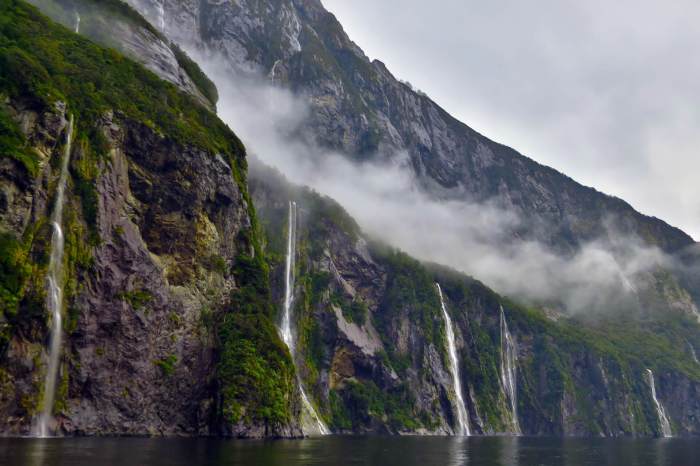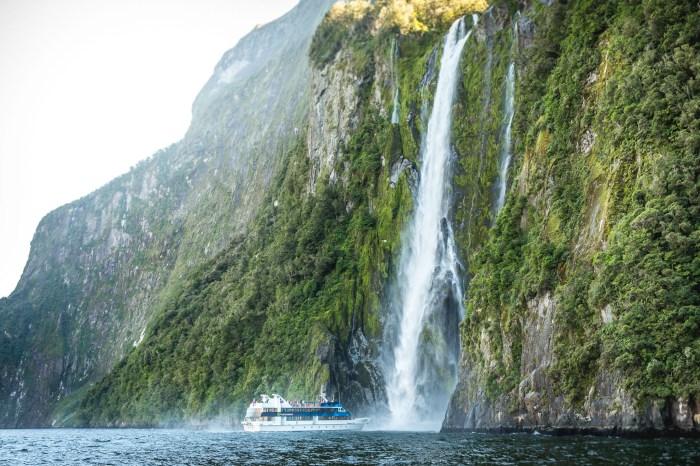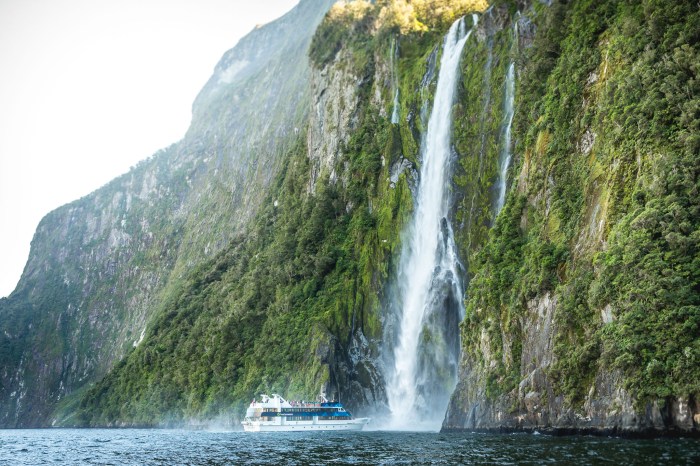Milford Sound waterfalls, nestled amidst the towering peaks of New Zealand’s Fiordland National Park, are a testament to nature’s artistry. These cascading wonders, steeped in Maori legend and geological intrigue, offer an awe-inspiring spectacle that captivates visitors with their ethereal beauty and profound significance.
From the thunderous Stirling Falls to the delicate Bridal Veil Falls, each waterfall tells a unique tale of geological forces, shaping the landscape over millennia. The surrounding flora and fauna, adapted to the waterfalls’ unique microclimate, create a vibrant tapestry of life that adds to the allure of this natural sanctuary.
Introduction
Nestled amidst the towering peaks of Fiordland National Park in New Zealand, Milford Sound is a breathtaking fjord renowned for its cascading waterfalls. These natural wonders, fed by the abundant rainfall and melting glaciers, plunge down sheer cliffs into the pristine waters below, creating a symphony of sights and sounds.
Milford Sound’s waterfalls hold deep cultural significance for the indigenous Māori people of New Zealand. According to legend, the waterfalls were formed by the tears of Hine-nui-te-pō, the goddess of death, as she mourned the loss of her beloved husband.
Types of Waterfalls: Milford Sound Waterfalls
Milford Sound boasts a diverse range of waterfalls, each showcasing unique characteristics and contributing to the region’s breathtaking scenery.
Plunge Waterfalls
Plunge waterfalls are characterized by their sheer drop and free fall into a pool or body of water below. In Milford Sound, notable examples include the Lady Bowen Falls, which plunge 162 meters into the Milford Sound, and the Stirling Falls, which cascade 151 meters from a hanging valley.
Cascade Waterfalls
Cascade waterfalls flow over a series of steps or ledges, creating a cascading effect. In Milford Sound, the Sutherland Falls is an iconic example of a cascade waterfall, with its three tiers cascading over 580 meters, making it one of the highest waterfalls in New Zealand.
Horsetail Waterfalls
Horsetail waterfalls resemble the tail of a horse, with a narrow stream of water falling from a steep cliff or overhang. Milford Sound features several horsetail waterfalls, including the Bridal Veil Falls, which flow down a sheer rock face into the Milford Sound.
Fan Waterfalls
Fan waterfalls spread out in a wide, fan-shaped pattern as they fall. In Milford Sound, the Giant Gate Falls is an impressive example of a fan waterfall, with its broad curtain of water cascading down a sheer cliff face.
Geological Formation
The breathtaking waterfalls of Milford Sound are a testament to the powerful geological forces that have shaped this majestic landscape. The interplay of glaciers, erosion, and tectonic activity has carved these natural wonders into the sheer cliffs that surround the sound.
Glacial Activity
During the last ice age, massive glaciers extended into Milford Sound, their relentless flow scouring the landscape and creating deep U-shaped valleys. As the glaciers retreated, they left behind hanging valleys, which became the source of many of the waterfalls in the sound.
Erosion
The relentless pounding of waves and the erosive power of rainwater have further shaped the waterfalls. The constant weathering of the cliffs has created sheer rock faces, which provide a perfect backdrop for the cascading waters.
Tectonic Activity
Milford Sound is located within the Fiordland National Park, an area known for its dramatic geological history. The collision of the Australian and Pacific tectonic plates has resulted in the uplift of the Southern Alps, creating the steep slopes that give rise to the waterfalls.
Flora and Fauna
The Milford Sound waterfalls are surrounded by a lush and diverse ecosystem. The spray from the waterfalls creates a moist environment that supports a wide variety of plants, including ferns, mosses, and liverworts. The surrounding forests are home to a variety of animals, including birds, reptiles, and mammals.
Plant Life, Milford sound waterfalls
The plant life around the Milford Sound waterfalls is dominated by ferns, mosses, and liverworts. These plants are well-adapted to the moist environment created by the spray from the waterfalls. Ferns are non-flowering plants that reproduce by spores. They have large, divided leaves that are well-suited for absorbing moisture from the air.
Mosses are small, non-vascular plants that lack true leaves and stems. They have a simple structure that consists of a stem-like axis with small, leaf-like structures. Mosses are able to absorb moisture directly from the air, which makes them well-suited for living in the moist environment around the waterfalls.
Liverworts are also small, non-vascular plants that lack true leaves and stems. They have a flattened, leaf-like structure that is divided into lobes. Liverworts are able to absorb moisture directly from the air, which makes them well-suited for living in the moist environment around the waterfalls.
Animal Life
The animal life around the Milford Sound waterfalls is dominated by birds, reptiles, and mammals. Birds are the most common animals in the area, and they include a variety of species, such as penguins, albatrosses, and petrels. Reptiles are also common in the area, and they include a variety of species, such as lizards and snakes.
Mammals are the least common animals in the area, and they include a variety of species, such as seals and sea lions.
The birds that live around the Milford Sound waterfalls are well-adapted to the cold, wet climate. They have thick feathers that help to keep them warm, and they have webbed feet that help them to swim in the water. The reptiles that live around the Milford Sound waterfalls are also well-adapted to the cold, wet climate.
They have scales that help to keep them dry, and they have strong claws that help them to climb on the rocks.
The mammals that live around the Milford Sound waterfalls are well-adapted to the cold, wet climate. They have thick fur that helps to keep them warm, and they have webbed feet that help them to swim in the water.
The cascading waterfalls of Milford Sound are a breathtaking sight, creating a majestic backdrop for any special occasion. Whether you’re celebrating a birthday or an anniversary, decorating your hotel room with thoughtful touches can enhance the experience. Consider creating a cozy ambiance with hotel room decoration for birthday ideas, such as fairy lights, balloons, and personalized messages.
After indulging in the picturesque views of Milford Sound’s waterfalls, retreat to your decorated hotel room for a memorable celebration.
Tourism and Accessibility
Tourism plays a significant role in Milford Sound, with the waterfalls being a major attraction. Visitors can experience the beauty of the waterfalls through boat tours or hiking trails.
Boat tours provide a unique perspective of the waterfalls, allowing visitors to get up close and personal with the cascading waters. The tours offer guided commentary, providing insights into the history, geology, and wildlife of the area.
Hiking Trails
For those who prefer a more active experience, there are several hiking trails that lead to different viewpoints of the waterfalls. The Milford Track, one of the most famous hikes in New Zealand, offers stunning views of the Sutherland Falls, the highest waterfall in the country.
Other popular trails include the Routeburn Track and the Hollyford Track, which provide access to other impressive waterfalls in the area.
Cultural and Historical Significance

The waterfalls of Milford Sound hold immense cultural and historical significance for the Maori people, who have inhabited the area for centuries.
According to Maori legend, the waterfalls were created by Tu Te Rakiwhanoa, the god of thunder and lightning. Tu Te Rakiwhanoa was angered by the disobedience of his son, Kahukura, and struck the mountain with his lightning bolts, creating the waterfalls as a symbol of his wrath.
Sacred Site
The waterfalls are considered a sacred site by the Maori people and are often used for ceremonies and rituals. The Maori people believe that the waterfalls have healing powers and that bathing in the water can bring good luck and fortune.
Legends and Stories
Many legends and stories are associated with the waterfalls. One legend tells the story of a young Maori woman who fell in love with a Pakeha (European) man. The woman’s father disapproved of the relationship and forbade her from seeing the man.
The woman was so heartbroken that she threw herself into the waterfalls and drowned.
Another legend tells the story of a Maori chief who was killed in a battle with a rival tribe. The chief’s body was thrown into the waterfalls, and his spirit is said to still haunt the area.
Environmental Conservation
Milford Sound is a protected area within the Fiordland National Park, which is a UNESCO World Heritage Site. As such, there are several conservation efforts in place to protect the waterfalls and their surroundings.
One of the main threats to the ecosystem is pollution. Visitors to the area are encouraged to dispose of their waste properly and to avoid littering. The Department of Conservation also conducts regular clean-ups of the area.
Wildlife Management
Another threat to the ecosystem is the introduction of invasive species. These species can compete with native species for food and resources, and they can also spread diseases. The Department of Conservation has implemented a number of measures to control the spread of invasive species, including border controls and quarantine measures.
Sustainable Tourism
Tourism can also have a negative impact on the environment. To minimize the impact of tourism, the Department of Conservation has implemented a number of sustainable tourism practices. These practices include limiting the number of visitors to the area, providing designated camping areas, and encouraging visitors to use eco-friendly transportation methods.
Thanks to these conservation efforts, Milford Sound remains a pristine and beautiful natural wonder. Visitors can enjoy the waterfalls and their surroundings without worrying about damaging the environment.
Photography and Art

Milford Sound’s majestic waterfalls present unparalleled opportunities for photography and artistic expression. Their sheer scale, cascading waters, and dramatic backdrop create a breathtaking canvas for capturing the beauty of nature.
Photographers flock to Milford Sound to capture the iconic images of the waterfalls. The thunderous Stirling Falls, with its twin streams plunging into the fjord, is a popular subject. Bowen Falls, surrounded by lush vegetation, offers a more intimate perspective.
Sutherland Falls, the tallest in New Zealand, commands awe with its sheer drop and powerful presence.
Artistic Interpretations
Milford Sound’s waterfalls have also inspired artists of all kinds. Painters have sought to capture the ethereal beauty of the falls, while sculptors have used their forms to create dynamic works of art. Musicians have composed melodies that evoke the sound of cascading waters, and poets have penned verses that celebrate their grandeur.
Scientific Research
Milford Sound’s waterfalls have been the subject of numerous scientific studies, focusing on their hydrology, ecology, and geological processes.
Hydrological research has investigated the flow rates, water quality, and sediment transport of the waterfalls. This information is crucial for understanding the dynamics of the waterfalls and their impact on the surrounding environment.
Ecology
Ecological studies have explored the diverse flora and fauna associated with the waterfalls. The waterfalls provide a unique habitat for a variety of plant and animal species, including mosses, ferns, lichens, and insects. Research has identified the specific adaptations these organisms have developed to survive in the spray and mist of the waterfalls.
Geological Formation
Geological studies have focused on the processes that shaped the waterfalls. Researchers have examined the rock formations, erosion patterns, and tectonic activity that have contributed to the creation of the waterfalls. This research provides insights into the long-term evolution of the landscape.
Educational Resources
The magnificent waterfalls of Milford Sound have inspired numerous educational resources that delve into their geological, ecological, and cultural significance. These resources provide valuable insights for students, researchers, and anyone seeking to deepen their understanding of this natural wonder.
The following list presents a selection of educational materials, each offering unique perspectives and content:
Books
- “Milford Sound: A Guide to the Fiordland National Park”by Geoff Chapple and Atholl Anderson (2008): This comprehensive guidebook provides detailed descriptions of the waterfalls, hiking trails, and other attractions within Milford Sound, along with historical and cultural information.
- “The Natural History of Milford Sound”by Alan Mark and Brian Gill (2005): This scientific text explores the geology, ecology, and climate of Milford Sound, offering insights into the formation and evolution of the waterfalls.
Documentaries
- “Milford Sound: Nature’s Masterpiece”(2016): This award-winning documentary showcases the stunning beauty of Milford Sound, capturing the grandeur of the waterfalls and the surrounding landscape.
- “Waterfalls of the World: Milford Sound”(2019): This documentary explores the unique geological and hydrological features that have shaped the waterfalls of Milford Sound.
Websites
- Department of Conservation- Milford Sound : This official website provides up-to-date information on the waterfalls, including their accessibility, conservation efforts, and safety guidelines.
- New Zealand Geographic- Milford Sound : This website features articles, photographs, and interactive maps that provide a comprehensive overview of Milford Sound, including its waterfalls.
Final Wrap-Up
Milford Sound waterfalls stand as a testament to the power and beauty of nature, inspiring awe and wonder in all who behold them. Their cultural, historical, and ecological importance makes them a cherished part of New Zealand’s heritage, calling for their continued protection and appreciation for generations to come.
Top FAQs
What is the tallest waterfall in Milford Sound?
Stirling Falls, with a height of 151 meters (495 feet).
What is the most popular waterfall in Milford Sound?
Sutherland Falls, renowned for its triple cascade and picturesque setting.
Can I swim in the Milford Sound waterfalls?
No, swimming is not permitted due to safety concerns and the preservation of the natural environment.



